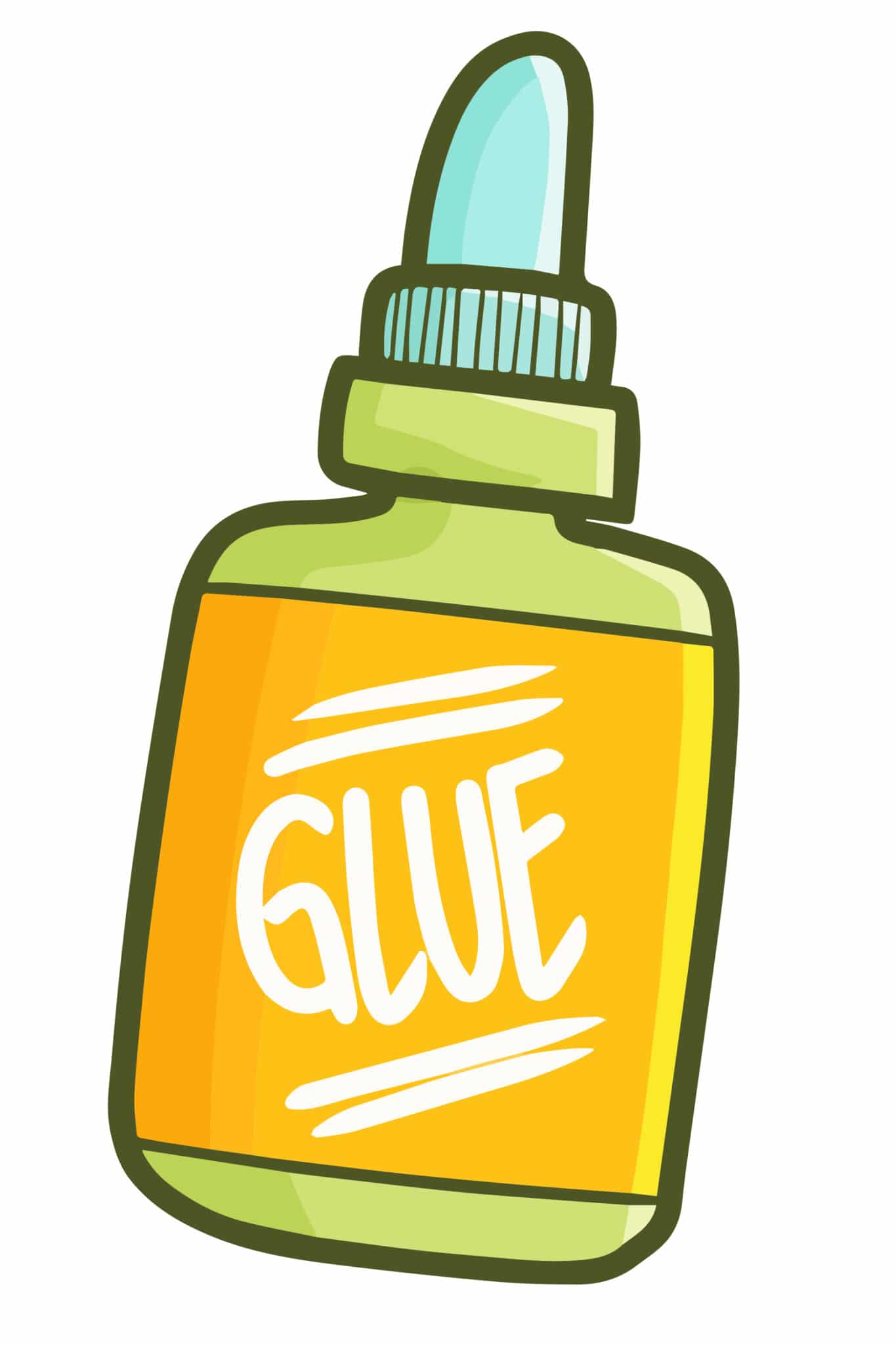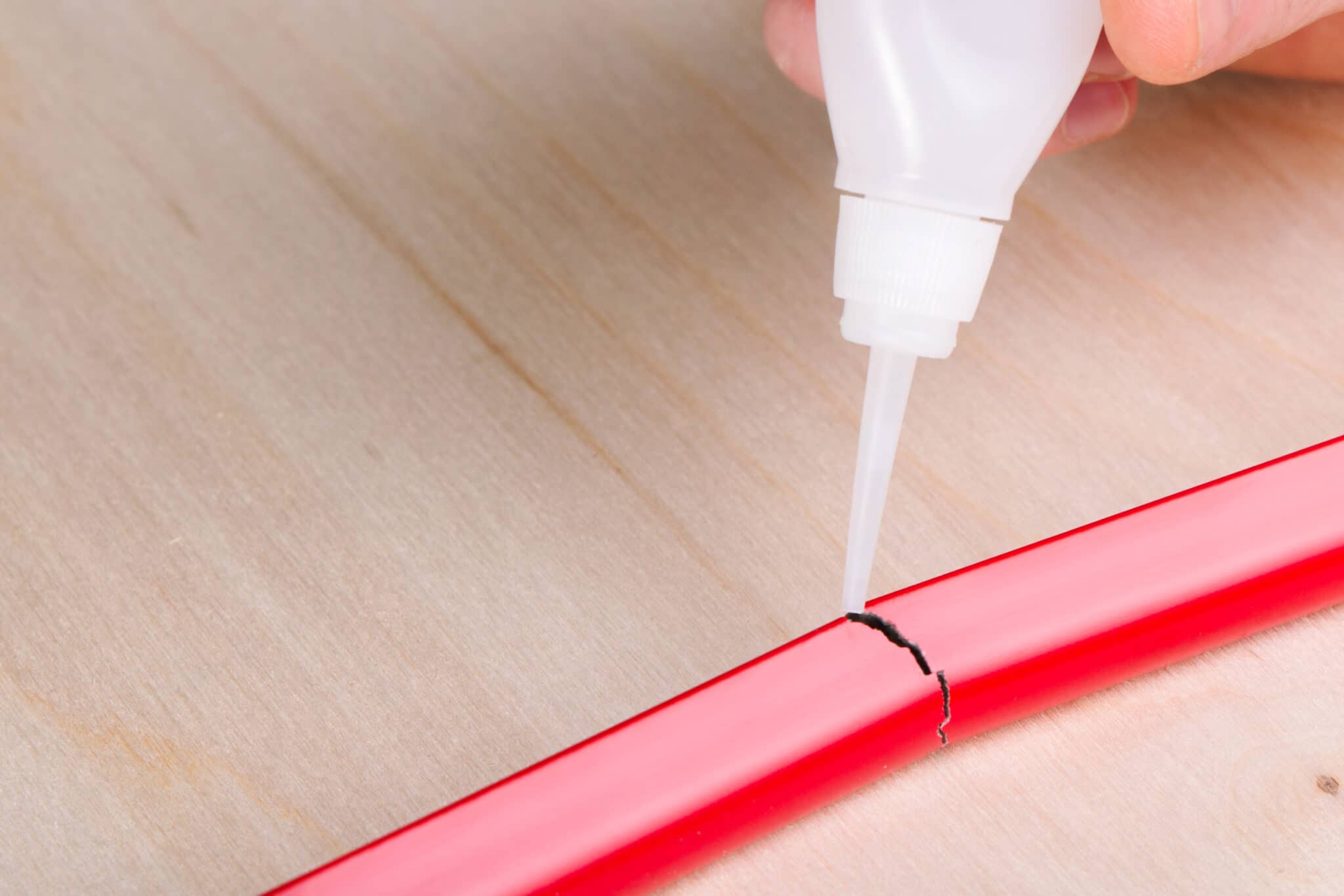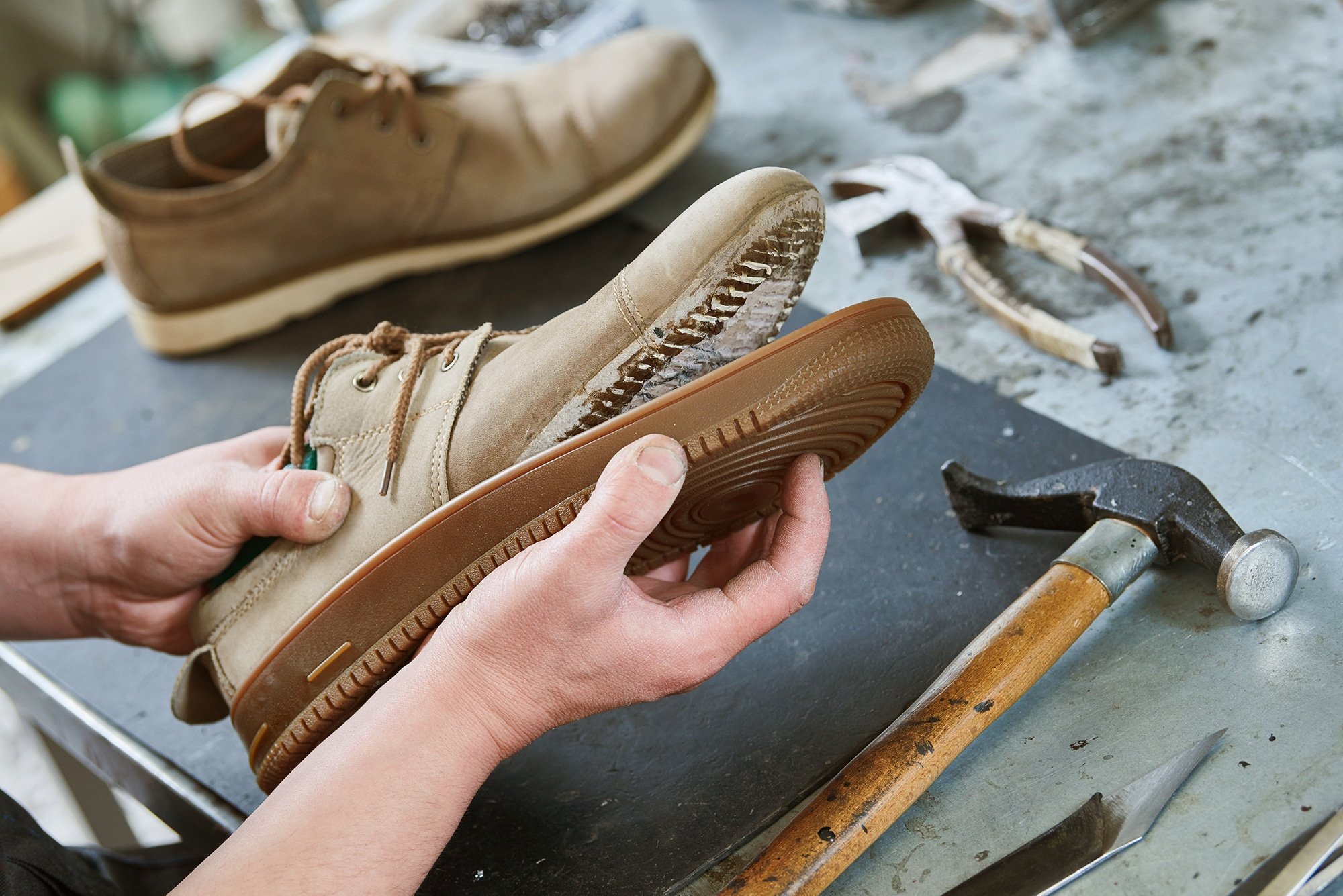Craft Glue 101: Your Guide to the Best Crafting Adhesives
It’s time to take the confusion out of craft glue! Here’s your guide to the best adhesives for every type of craft or office project you work on.
Did you know that different types of glue adhere to different materials? I remember when I first learned that important tidbit. I was in the craft store looking for “glue” and was completely overwhelmed by the number of different glue products stocked on the shelves.
It was a major “ah-ha” moment that completely transformed how I approached crafting projects.
Before that, I had always thought that glue was glue. Well, maybe there was a difference between Elmer’s glue and super glue, but that was about the extent of it…and then I scratched my head and wondered why my wood crafts fell apart when I used Elmer’s glue. True story.
Now that I have loads of experience under my belt, and am sharing it with you today with the hope that you can skip that overwhelming experience of walking into a store to buy “glue” because you’ll know exactly what you need!
Table of contents

Tips For Choosing The Best Glues For Crafting
It’s essential to use the right supplies in order to successfully make beautiful projects, and knowing which craft supplies are the best to use can be challenging to say the least.
Take craft glue, for example.
Did you know there were so many options for craft adhesives?
After reading today’s post, you can eliminate the guesswork of picking a craft adhesive and put that energy and time back into doing what you love: making amazing crafts!
Whether you’re making a complicated fabric craft project, or just repairing a broken ceramic vase, this guide will help you choose the right type of glue for different types of materials.
Use these tips as a general guide, then read below to learn which adhesives work best with different crafting materials.
- As wonderful as it would be to use a “one glue fits all” solution, crafting involves too many different types of surfaces and materials to make that possible. There is no such thing as an all purpose craft glue. For best results, you need to choose the right type of glue for your project.
- Several options can be used on multiple surfaces, and as a result, most crafters will have a favorite glue that they use often.
- Different types of glues are needed for bonding porous materials (paper, wood, etc.) and non-porous materials (plastic, rubber, etc.).
- Your first step is to determine what materials you will be glueing, and choose an adhesive from there.
- If you can, test the glue you want to use for your project before diving in.
Craft Glue 101: The Best Adhesives For Your Different Craft Projects
This post may contain affiliate links. If you click one and make a purchase, I may receive a commission at no additional cost to you. You can check out our full disclosure policy here.
Speaking of diving in, let’s jump into learning about glue!
When I was learning about craft glues, one major flaw I found was that most sites tend to list individual glues and state what materials they adhere to.
There can be some overlap in which materials a particular glue works well with. I found it tough to keep track of which products I could use when working with plastic versus when I was working with fabric.
So I put together a list of common crafting materials and the best craft glues to use when working with them to solve that problem for you. Essentially, I created my list in reverse order, starting with the materials, and listing the different kinds of glue that will work on each.
NOTE: These adhesives are available at large stores such as Michaels, Hobby Lobby, Walmart, and online through Amazon sites. I include Amazon links to make it easy for you to find them and research them further.
Best Basic Craft and Office Glue
If you’re a crafter who likes to do one type of project one day and then jump to an entirely different type of project, it might be a good idea to have a good all-around glue (or two!) on hand. I recommend having these all-round craft and office glues:
Aleene’s Tacky Glue – It’s one of the most commonly used adhesives for crafters. This product has withstood the test of time and continues to be a favorite craft and office glue. This is the best white glue option out there. Use it with paper, fabric, plastic, and felt. It dries clear but stays flexible.
Hot Glue Gun – This might be the one universal glue that every crafter has. It works on most porous surfaces and non-porous materials and is best used for typical craft projects when you need fast adhesion and little to no dry time. You can even get the sticks in different colors! Glue guns work by melting hot glue sticks, so take care not to burn yourself by touching the hot tip. I always recommend gloves when working with high temperatures.
Spray Adhesive – Spray adhesives are not especially strong, but they do have their uses. There are a variety of formulas for use on different materials, but for the most part spray adhesives are a “Jack-of-all-trades” solution. What they do excel at is giving a thin, even coat over large areas, which is great for glitter applications. There are also reposition-able formulas that are great for stencilling projects.
Mod Podge – Last but not least… Mod Podge has been around for a long time and will continue to be popular as it can be used to glue, seal, and finish projects. This clear glue is available in a range of finishes from matte to glossy. It’s probably the number one decoupage glue for decoupage projects!




Best Glue For Plastic Crafts
Plastic is a non-porous material, so you need to use special glues designed to adhere to your plastic crafts. I recommend these craft glue products.
Loctite Epoxy Plastic Bonder – This adhesive works really well with plastics, and it’s very resistant to moisture, high humidity, and impact.
Gorilla Super Glue Gel – This is a terrific product that does work well with multiple surfaces including plastic, ceramic, rubber, leather, metal, paper, wood, and more. It’s a very strong glue and is impact resistant. Plus, the gel formula helps prevent messes. The best part is that it bonds almost instantly, with no need for clamping or holding pieces together for minutes.
E6000 – This is my favorite glue for a variety of non-paper craft projects. It bonds to plastic, wood, ceramic, rubber, leather, fabric, and more. Plus, it’s paintable, dries clear, photo safe, washer & dryer safe, and temperature resistant. It’s the closest thing to a multi purpose glue out there.




Best Glue For Ceramics
Ceramics are porous but they can be tricky to glue together because you need glue that can withstand some impact and has the ability to be painted. Safety note: Most glues are not food safe. Do not use glued ceramic objects for cooking or eating. I like using these crafting glues for ceramic items and porcelain repairs:
E6000 – This is a good ceramic glue because it’s flexible, and gives you 5 minutes of time to adjust your ceramic pieces as needed until it’s permanently bonded (great for ceramic repair!). Note: One “con” to E6000 is the odor. Make sure to work with it in a well-ventilated area.
Gorilla Super Glue Gel – If you have ceramic products with lots of broken pieces, your best option is probably a fast-bonding ceramic adhesive like Super Glue. You will save a ton of time by not having to hold each bond for 5 minutes while the glue sets. Be aware that super glue is toxic, so definitely do not use repaired dishes for food!
Aleene’s Tacky Glue – This great all-around glue is also a good option for ceramics! I wish I had this when I was a kid, I bet my mom wishes I had it too. Sorry about your favorite ceramic mug, mom!



Best Glue For Wood Projects
Wood can be tricky to glue because it’s very porous and can have a very uneven surface. The key to a strong bond with wood is to use a thin layer of glue, and use as many clamps as you can. If you don’t have clamps you can use something heavy to press your project together, although the bond may be weaker. For top-notch looking wood craft projects, use one of these products:
Wood Glue – This glue works really well for gluing wood to wood, which is really all I recommend using it for. When used properly, wood glue will give a permanent bond, suitable for structural applications like furniture. This often makes it your best choice for wood projects. We use the wood glue formula by Gorilla Glue for all our DIY woodworking projects.
Aleene’s Tacky Glue – Have I mentioned how wonderful this glue is? Not only does it work on paper, felt, fabric, plastic, and ceramics, but it also adheres to wood.
E6000 – Yes, E6000 works on wood too! This stuff is seriously amazing.




Best Glue For Leather
Leather is a type of fabric that can present a challenge for adhesives. These products will create an unstoppable bond with leather.
Barge All-Purpose Cement – Barge All Purpose Cement is probably the best adhesive for leather, and it has a bond strength far superior to regular rubber cement. This glue requires adding the glue to both surfaces and drying for up to 15 minutes before securing the pieces together, but the bond is instant, with no need for clamping or holding. Be sure to use in a well ventilated area, even with the toluene-free formula (blue packages).
Gorilla Super Glue – This craft glue goes on strong and never lets go. It creates very flexible but highly impact-resistant bonds. It’s water-proof, works well at adhering different materials together, and works well with porous and non-porous materials.
E6000 – It really is about as close as it gets to a one-glue-fits-all, and is great for water resistant applications like leather projects.




The Best GLUE FOR FABRIC
Fabrics need special adhesives as well. Fabric glue can be a real time-saver for those of use with limited sewing skills. These two products will cover almost any fabric craft you do.
Beacon Fabri-Tac – This reliable fabric adhesive is one of the best on the market. This craft glue dries clear, is machine washable, flexible, and terrific to work with because it doesn’t seep through fabrics, making it perfect for no-sew projects. I love no-sew projects!
Aleene’s Tacky Glue – A mainstay in the crafting world for a reason, you can use this craft glue on your no-sew projects!



Best Glue For Paper To Paper Crafts
Papercraft projects require a special touch of their own. I recommend using these craft glue recommendations for paper.
Glue Dots – These are amazing for papercrafts. They eliminate dry time and mess, are acid-free and non-toxic, and are perfect for photos, greeting cards, gift tags, scrapbooking, and other paper projects.
Aleene’s Tacky Glue – It’s strong but flexible. Dries clear and doesn’t make paper bubble up. This product has proven itself time and time again.
Spray Adhesive – Because spray adhesive gives a thin, even coat, it works quite well on paper projects. If you’ve ever used white glue on paper, only to have the paper get all wrinkly from absorbing the glue, you’ll know the frustration that uneven coats of glue can cause. Spray glues do not have this problem. There are also “photo safe” options for color safe applications.
Glue Sticks – If you craft with your kids, glue sticks are a must-have. They work well for a paper to paper crafts, dry clear, and minimize messes. Tip: Glue sticks don’t work for other crafts, including scrapbooking. Leave the glue sticks for the kids’ school projects, and invest in higher quality glue for your projects.



Best Glue For Rubber Projects
Rubber is one of the most resistant materials for creating strong bonds with adhesives. That’s why you’ll want to use one of these two craft glues with rubber.
E6000 – This crafting glue bonds to materials like rubber, that many other adhesives can’t. This product is a must-have if you like to craft with a variety of materials. It doesn’t create an instant bond, but that can work in your favor if you need to adjust something before the bond sets.
Gorilla Super Glue – Most adhesives don’t bond to rubber well, however, “super glue” or “Krazy glue” (aka the cyanoacrylate adhesives family) does.
Barge All-Purpose Cement – Perfect for rubber and foam. This glue requires adding the glue to both surfaces and drying for up to 15 minutes before securing the pieces together. With that said, this is my husband’s go-to glue for anything foam or rubber. He swears by it.




Since there’s no “one glue fits all” solutions for crafting with a variety of materials, this list gives you the best craft glue products for each crafting material to help you feel confident about which types of adhesive to use on your next crafting project!
If I missed any of your favorite glues, drop a comment below and let me know what you’re using, what you’re loving, and your recommendations. I’d LOVE to hear all about them.
I’m a weirdo.
Super glue is usually the fastest drying glue for crafts, and creates an almost instant bond on most materials. Be sure to check if it will work on your project materials before using it.
Super glues, or the cyanoacrylate family of adhesives, are not food safe. Even once fully cured they can give off toxic chemicals. Do not ceramic items that have been glued for cooking or eating.
Unfortunately no one glue can do it all. Different glues work on different materials. Your best bet is to determine the best type of glue for your project based on the materials you are trying to stick together.
Working time is the amount of time you have from the time you apply the glue until the time the glue will no longer form a bond. Basically it’s the amount of time you have to stick the two items together before the glue won’t work.
Drying time simply means the amount of time for all the liquid to evaporate from the glue. This doesn’t mean that the glue is at full strength though, because most glues undergo chemical changes even after they are “dry” that are the source of the glue’s strength. The amount of time it takes for the glue to undergo these changes is called “curing time.” Glues are not at their full strength until fully cured.
Editorial note: this post was originally published January 7, 2021, and updated on February 4, 2022.
Looking for Crafting Guides?
We have a few guides you may find informative:
- The Best Jumbo Yarns – Tested
- How To Dry & Preserve Flowers – Tested
- The Best Way to Dry Rose Petals – Tested






Hi Laura. Great article. I am wondering for those of us who work with metal embellishments and small metal pieces, which is the best for this? I glue them to all sorts of things.
Hi Traci, for gluing small metal parts to anything, it’s best to use glue like Aleene’s Jewelry and Metal Glue. It’s an instant bond glue, and gel-based so it doesn’t run (which is a huge issue when dealing with small bits). Hope that helps!